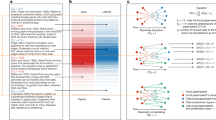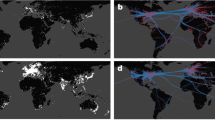Abstract
The integrated circuit is today synonymous with the concept of technological progress. In the seven decades since the invention of the transistor at Bell Labs, relentless progress in the development of semiconductor devices — Moore’s law — has been achieved despite regular warnings from industry observers about impending limits. Here, drawing on technical and organizational archival work and oral histories, we argue that the current technological and structural challenges facing the industry are unprecedented and undermine the incentives for continued collective action in research and development, which has underpinned the past 50 years of transformational worldwide economic growth and social advance. We conclude by arguing that the lack of private incentives, due in part to a splintering of technology trajectories and short-term private profitability of many of these new splinters, creates a case for greatly increased public funding and the need for leadership beyond traditional stakeholders.
This is a preview of subscription content, access via your institution
Access options
Access Nature and 54 other Nature Portfolio journals
Get Nature+, our best-value online-access subscription
$29.99 / 30 days
cancel any time
Subscribe to this journal
Receive 12 digital issues and online access to articles
$119.00 per year
only $9.92 per issue
Buy this article
- Purchase on Springer Link
- Instant access to full article PDF
Prices may be subject to local taxes which are calculated during checkout




Similar content being viewed by others
Change history
05 February 2018
In the version of this Perspective originally published, in the penultimate paragraph 'Office for Nuclear Regulation' should have read 'Office of Naval Research'. This has now been corrected.
References
Rosenberg, N. & Trajtenberg, M. A General-purpose technology at work: the Corliss steam engine in the late-nineteenth-century United States. J. Econ. Hist. 64, 61–99 (2004).
Jorgenson, D. W. Information technology and the U.S. economy. Am. Econ. Rev. 91, 1–32 (2001).
Jorgenson, D. W. & Vu, K. Information technology and the world growth resurgence. Ger. Econ. Rev. 8, 125–145 (2007).
The news of Radio: two new shows on CBS will replace ‘Radio Theatre’ during the summer. New York Times 46 (1 July 1948).
Watzinger, M., Fackler, T. A., Nagler, M. & Schnitzer, M. How Antitrust Enforcement Can Spur Innovation: Bell Labs and the 1956 Consent Decree (2017); http://voxeu.org/article/how-antitrust-enforcement-can-spur-innovation
Early, J. M. Maximum rapidly-switchable power density in junction triodes. IRE Trans. Electron Devices 6, 322–325 (1959).
Goldey, J. & Ryder, R. Are transistors approaching their maximum capabilities? in 1963 IEEE Int. Solid-State Circuits Conf. Digest of Technical Papers VI, 20–21 (1963).
Wallmark, J. & Marcus, S. Minimum size and maximum packing density of nonredundant semiconductor devices. Proc. IRE 50, 286–298 (1962).
Johnson, E. Physical limitations on frequency and power parameters of transistors. IRE Int. Convention Record 13, 27–34 (1965).
Morton, J. & Pietenpol, W. The technological impact of transistors. Proc. IRE 6, 955–959 (1958).
Holbrook, D. Government support of the semiconductor industry: diverse approaches and information flows. Bus. Econ. Hist. 24, 133–165 (1995).
Moore, G. E. Cramming more components onto integrated circuits. Electronics 38, 114–117 (1965).
Dennard, R. H., Gaensslen, F. H., Rideout, V. L., Bassous, E. & LeBlanc, A. R. Design of ion-implanted MOSFETs with very small physical dimensions. IEEE J. Solid-State Circuits 9, 256–268 (1974).
Moore, G. E. Progress in digital integrated electronics. 1975 Int. Electron Devices Meeting Technical Digest 21, 11–13 (1975).
Baccarani, G., Wordeman, M. R. & Dennard, R. H. Generalized scaling theory and its application to a 1/4 micrometer MOSFET design. IEEE Trans. Electron. Devices 31, 452–462 (1984).
Ouchi, W. G. Political and economic teamwork: the development of the microelectronics industry of Japan. Calif. Manage. Rev. 26, 8 (1984).
Burger, R. M. Cooperative Research: The New Paradigm (2000); https://www.src.org/about/p001960.pdf
Browning, L. D. & Shetler, J. C. SEMATECH: Saving the U.S. Semiconductor Industry (Texas A&M Univ. Press, Texas, 2000).
Spencer, W. J. & Grindley, P. SEMATECH after five years: high-technology consortia and US competitiveness. Calif. Manag. Rev. 35, 9–9 (1993).
Grindley, P., Mowery, D. C. & Silverman, B. SEMATECH and collaborative research: Lessons in the design of high-technology consortia. J. Policy Anal. Manag. 13, 723–758 (1994).
Macher, J. T., Mowery, D. C. & Hodges, D. A. Reversal of fortune? The recovery of the U.S. semiconductor industry. Calif. Manag. Rev. 41, 107–136 (1998).
Carayannis, E. G. & Alexander, J. Strategy, structure, and performance issues of precompetitive R&D consortia: insights and lessons learned from SEMATECH. IEEE Trans. Eng. Manag 51, 226–232 (2004).
Macher, J. T., Mowery, D. C. & Di Minin, A. in U.S. Industry in 2000: Studies in Competitive Performance (ed. Mowery, D. C.) 245–286 (National Academies Press, Washington DC, 1999).
Macher, J. T. & Mowery, D. C. Vertical specialization and industry structure in high technology industries. Adv. Strateg. Manag. 21, 317–355 (2004).
Angel, D. P. New firm formation in the semiconductor industry: elements of a flexible manufacturing system. Reg. Stud. 24, 211–221 (1990).
Kapoor, R. Persistence of integration in the face of specialization: how firms navigated the winds of disintegration and shaped the architecture of the semiconductor industry. Organ. Sci. 24, 1195–1213 (2013).
Lim, K. The many faces of absorptive capacity: spillovers of copper interconnect technology for semiconductor chips. Ind. Corp. Change 18, 1249–1284 (2009).
Mowery, D. C. & Rosenberg, N. Technology and the Pursuit of Economic Growth (Cambridge Univ. Press, Cambridge, 1991).
Rosenbloom, R. S. & Spencer, W. J. (eds) Engines of Innovation: U.S. Industrial Research at the End of an Era (Harvard Business School Press, Boston, 1996).
Schaller, R. R. Technological Innovation in the Semiconductor Industry: A Case Study of the International Technology Roadmap for Semiconductors (ITRS). PhD thesis, George Mason Univ. (2004).
Mollick, E. Establishing Moore’s Law. IEEE Ann. Hist. Comput. 28, 62–75 (2006).
Gargini, P. in 22nd Annual IEEE Gallium Arsenide Integrated Circuits Symp. Technical Digest 2000 3–5 (2000).
Spencer, W. J. & Seidel, T. E. in Productivity and Cyclicality in Semiconductors: Trends, Implications, and Questions — Report of a Symposium 135 (NRC, 2004).
National Research Council Securing the Future: Regional and National Programs to Support the Semiconductor Industry (The National Academies Press, Washington DC, 2003); https://doi.org/10.17226/10677
Packan, P. A. Pushing the limits. Science 285, 2079–2081 (1999).
Thompson, N. The economic impact of Moore’s Law: evidence from when it faltered. SSRN Electron. J. https://doi.org/10.2139/ssrn.2899115 (2017).
National Research Council. The Future of Computing Performance (National Academies Press, Washington DC, 2011).
Ho, M. S., Jorgenson, D. W. & Samuels, J. D. Information technology and U.S. productivity growth: evidence from a prototype industry production account. J. Product. Anal. 36, 159–175 (2011).
International Technology Roadmap for Semiconductors 2.0 (ITRS, 2016); http://www.itrs2.net
Natarajan, S. et al. A 14 nm logic technology featuring 2nd-generation FinFET, air-gapped interconnects, self-aligned double patterning and a 0.0588 µm2 SRAM cell size. 2014 IEEE International Electron Devices Meeting 3.7.1–3.7.3 (2014); https://doi.org/10.1109/IEDM.2014.7046976
Horowitz, M. 1.1 Computing’s energy problem (and what we can do about it). IEEE Int. Solid-State Circuits Conf. Digest of Technical Papers 57, 10–14 (2014).
Huang, W., Rajamani, K., Stan, M. R. & Skadron, K. Scaling with design constraints: predicting the future of big chips. IEEE Micro 31, 16–29 (2011).
Cutress, I. Intel’s ‘Tick-Tock’ seemingly dead, becomes ‘process-architecture-optimization’. AnandTech (22 March 2016).
Hruska, J. Nvidia deeply unhappy with TSMC, claims 20 nm essentially worthless. ExtremeTech (23 March 2012).
Bohr, M. Technology Leadership (2017); https://newsroom.intel.com/newsroom/wp-content/uploads/sites/11/2017/09/mark-bohr-on-intels-technology-leadership.pdf
Zeng, W. et al. First quantum computers need smart software. Nature 549, 149–151 (2017).
International Technology Roadmap for Semiconductors (ITRS, 2001); http://www.itrs2.net/itrs-reports.html
International Technology Roadmap for Semiconductors (ITRS, 2003); http://www.itrs2.net/itrs-reports.html
Zhirnov, V. V., Cavin, R. K., Hutchby, J. A. & Bourianoff, G. I. Limits to binary logic switch scaling — a gedanken model. Proc. IEEE 9, 1934–1939 (2003).
Galatsis, K. et al. Nanoelectronics research gaps and recommendations: a report from the International Planning Working Group on Nanoelectronics (IPWGN) [Commentary]. IEEE Technol. Soc. Mag. 34, 21–30 (2015).
National Academies of Sciences Engineering and Medicine. Triennial Review of the National Nanotechnology Initiative (National Academies Press, Washington DC, 2016).
PCAST. Report to the President: Ensuring Long-Term U.S. Leadership in Semiconductors (Executive Office of the President, Washington DC, 2017).
Chen, A., Hutchby, J., Zhirnov, V. V. & Bourianoff, G. Emerging Nanoelectronic Devices (Wiley Blackwell, Hoboken, 2015).
Merritt, R. China’s SMIC, Q’comm in 14 nm deal. EETimes (23 June 2015).
Flemish Government increases financial support of imec IMEC (21 February 2017); https://www.imec-int.com/en/articles/flemish-government-increases-financial-support-of-imec
Brillouet, M. et al. Regional, national, and international nanoelectronics research programs: topical concentration and gaps. Proc. IEEE 98, 1993–2004 (2010).
Powell, W. W. & Grodal, S. in The Oxford Handbook of Innovation (eds Fagerberg, J., Mowery, D. C. & Nelson, R. R.) 56–85 (Oxford Univ. Press, Oxford, 2005).
Nelson, R. R. Uncertainty, learning, and the economics of parallel research and development efforts. Rev. Econ. Stat. 43, 351 (1961).
Scherer, F. M. Parallel R&D Paths Revisited (Harvard Kennedy School of Governemnt, Harvard, 2011).
Gargini, P. Industrial Research Institute — Concept. Presentation to SIA TSC (14 January 2004).
Levin, R. C. in Government and Technical Progress : A Cross-Industry Analysis (ed. Nelson, R. R.) (Pergamon, Oxford, 1982).
ICE. Status of Integrated Circuits Reports, 1970–1997. Integrated Circuit Engineering Archives at National Museum of American History (Smithsonian Institution, Washington DC, 2016).
Standard & Poor’s. Complete Financial Statements: Advanced Micro Devices Inc, Intel Corporation, International Business Machines Corp., Micron Technology, Inc., Texas Instruments Inc. from Compustat Database (Retrieved 14 May 2013).
Acknowledgements
We thank the NSF Graduate Research Fellowship Program, the NIST (award no. 28994.1.1080278) and the NSF’s Science of Science and Innovation Policy Program (award no. 28935.1.1121844) for funding this research. We also thank the 50 individuals from across industry, academia and government who agreed to oral histories, the many individuals around the industry who took the time to provide feedback, and the Semiconductor Research Corporation for granting us access to their archives.
Author information
Authors and Affiliations
Contributions
H.N.K. was involved in all aspects of writing the paper including project development, data collection, data analysis, discussion and writing. D.H. was involved in project planning, development, data collection, data analysis, discussion and writing. E.R.H.F. was involved in project initiation, planning, development, data analysis, discussion and writing.
Corresponding author
Ethics declarations
Competing interests
The authors declare no competing financial interests.
Additional information
Publisher’s note: Springer Nature remains neutral with regard to jurisdictional claims in published maps and institutional affiliations.
A correction to this article is available online at https://doi.org/10.1038/s41928-018-0031-2.
Rights and permissions
About this article
Cite this article
Khan, H.N., Hounshell, D.A. & Fuchs, E.R.H. Science and research policy at the end of Moore’s law. Nat Electron 1, 14–21 (2018). https://doi.org/10.1038/s41928-017-0005-9
Received:
Accepted:
Published:
Issue Date:
DOI: https://doi.org/10.1038/s41928-017-0005-9
This article is cited by
-
Facets Formation of Ag3Sn Intermetallic in Sn-Bi-Ag Alloys: An EBSD and First-Principles Study
JOM (2024)
-
Low-thermal-budget synthesis of monolayer molybdenum disulfide for silicon back-end-of-line integration on a 200 mm platform
Nature Nanotechnology (2023)
-
LICOM3-CUDA: a GPU version of LASG/IAP climate system ocean model version 3 based on CUDA
The Journal of Supercomputing (2023)
-
Estimating feature importance in circuit network using machine learning
Multimedia Tools and Applications (2023)
-
TXV Technology: The cornerstone of 3D system-in-packaging
Science China Technological Sciences (2022)



